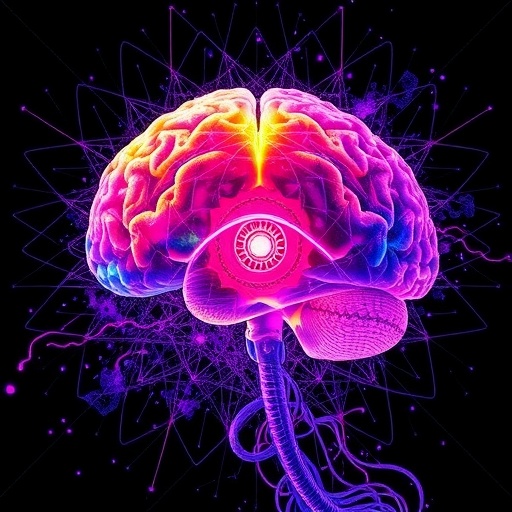In recent years, the therapeutic potential of psychedelics for treating psychiatric disorders has gained substantial momentum, shifting from societal taboo to a promising frontier in neuropsychopharmacology. Groundbreaking research has illuminated the intricate mechanisms by which these compounds exert profound effects on brain function. A new study published in eNeuro by a team led by Pavel Ortinski from the University of Kentucky delves deep into how psychedelics modulate synaptic plasticity in a brain region that has historically eluded neuroscientific understanding—the claustrum.
The claustrum, a slender and enigmatic sheet of neurons nestled deep beneath the cortex, has been postulated to act as a central hub integrating various neural signals. It is endowed with a high density of receptors that psychedelics commonly target, yet its precise functional contributions remain enigmatic. Ortinski’s study utilized male rat models to explore how psychedelic compounds influence the claustrum neurons, particularly those projecting to the anterior cingulate cortex (ACC), a cortical area critically implicated in cognitive processing and psychiatric conditions such as depression, anxiety, and schizophrenia.
Employing advanced electrophysiological recording techniques, the researchers observed that psychedelic exposure reversed the typical polarity of long-term synaptic plasticity within these claustrum neurons. Under normal physiological conditions, activating these neurons produced a form of synaptic weakening known as long-term depression (LTD). Intriguingly, psychedelic treatment shifted this response to long-term potentiation (LTP), a process fundamentally associated with strengthening synaptic connections and the encoding of memories.
This reversal of synaptic plasticity polarity was specific to the claustrum neurons projecting onto the ACC and did not manifest in the absence of psychedelic administration. Such specificity suggests that psychedelics uniquely engage the claustrum-ACC circuitry to modulate cognitive functions. The implications of these findings are profound, as synaptic plasticity stands at the core of how neurons adapt and reorganize in response to experiences, potentially underpinning the long-lasting therapeutic effects observed in clinical settings.
Ortinski and his team theorize that the hallmark intensely vivid and memorable experiences during psychedelic ‘trips’ might arise from this mechanism. By shifting synaptic plasticity to favor potentiation, psychedelics could intensify the encoding of specific neural circuits, thereby consolidating therapeutic memories that alleviate psychiatric symptoms. This aligns with psychological models suggesting that the transformative effects of psychedelics hinge on heightened experiential salience and emotional processing.
Moreover, the research adds a nuanced layer to the understanding of serotonin receptor signaling—a major biochemical substrate for psychedelics. The observed plasticity shifts are likely mediated through 5-HT2A receptor activation within the claustrum, influencing downstream intracellular cascades that regulate synaptic strength. This aligns with broader themes in neuropharmacology linking serotonin receptor modulation to psychiatric symptomatology and therapeutic recovery.
The findings challenge previous conceptions that psychedelics simply disrupt normal brain activity. Instead, they reveal a sophisticated modulation of synaptic dynamics within specific neural circuits important for cognition and emotion regulation. Such insights could pave the way for targeted therapies that harness psychedelic mechanisms without necessarily inducing hallucinogenic effects, potentially broadening the therapeutic toolkit for intractable mental illnesses.
Future research will need to investigate whether this polarity reversal mechanism operates similarly in humans and across different psychiatric diseases. Additionally, understanding how this synaptic plasticity modulation interacts with other brain regions involved in mood regulation and executive function could illuminate the systemic effects of psychedelic therapies. Ortinski’s work sets the stage for these investigations, providing a crucial piece of the complex puzzle linking brain plasticity, cognition, and mental health.
Ultimately, this study exemplifies the vibrant intersection of molecular neuroscience, pharmacology, and psychiatry. By elucidating how psychedelics reverse long-term plasticity polarity in a brain region integrally connected to cognitive control, it offers a compelling explanation of the neurobiological underpinnings of psychedelic-assisted therapy. This could herald a new era of science-driven, mechanism-based psychiatric treatments grounded in the biology of brain plasticity.
As the societal and clinical acceptance of psychedelic research accelerates, such mechanistic work is vital. It not only demystifies the action of these compounds but also helps refine their therapeutic use, facilitate regulatory approval, and tailor interventions to maximize benefit and minimize risks. The claustrum, long regarded as a mysterious cerebral player, is now illuminated as a key substrate in the dialogue between psychedelics and psychiatric symptom relief.
Pavel Ortinski and colleagues’ study in eNeuro represents a landmark in psychedelic neuroscience. By revealing how psychedelics fundamentally alter synaptic communication within the claustrum-ACC pathway, it opens a new window onto the neurophysiological basis of cognition and emotion modulation. This knowledge will undoubtedly inspire further research aimed at harnessing the plastic potential of the brain to treat psychiatric disorders in novel and effective ways.
As neuroscience unwraps these layers of complexity, the future of psychiatric medicine appears increasingly intertwined with the delicate art of modulating brain plasticity. Psychedelic compounds, through mechanisms such as those elucidated by Ortinski’s team, may finally realize their vast therapeutic promise, transforming mental health care for millions worldwide.
Subject of Research: The effects of psychedelics on synaptic plasticity in claustrum neurons projecting to the anterior cingulate cortex.
Article Title: Psychedelics Reverse the Polarity of Long-Term Synaptic Plasticity in Cortical-Projecting Claustrum Neurons
News Publication Date: 27-Oct-2025
Web References:
DOI: 10.1523/ENEURO.0047-25.2025
Keywords: Psychiatric disorders, Medical treatments, Drug therapy, Serotonin, Serotonin receptor signaling
Tags: anterior cingulate cortex and mental healthclaustrum role in neural integrationelectrophysiological techniques in neuroscienceimplications of psychedelics for depression and anxietyinnovative research in brain sciencemale rat models in psychedelic researchmechanisms of psychedelics on brain functionneuropsychopharmacology advancementspsychedelic therapy for psychiatric disorderssynaptic plasticity and psychedelicstherapeutic potential of psychedelicsunderstanding brain regions affected by psychedelics





